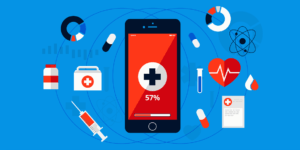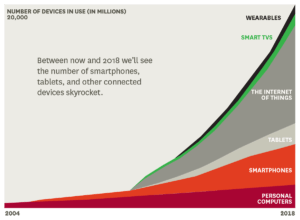The Internet of Things: Your Future Doctor!

“Imagine you walk into a room, and the room is dynamic. With your permission, you are interacting with things going on in the room”. – Eric Schmidt, Google chairman, on IoT[0]

IoT? What’s that?
The World Economic Forum predicts that the Internet of Things (IoT) will dramatically impact value chains, business models, and workforces in industries that account for two-thirds of the global GDP1. IoT refers to the process of adding sensors to machines and wirelessly connecting them to a common, cloud-based software platform2 so that these “smart” machines can “talk” to each other3.
Imagine a bridge built with smart cement4, i.e. cement equipped with sensors to monitor cracks. It would never collapse because we would repair it when the cement alerts us of cracks. Or if the cement monitors ice, it could send signals to cars to slow down, preventing accidents!
IoT can save lives.
IoT is transforming healthcare. Earlier this year, doctors in New Jersey used heart-rate data from a patient’s Fitbit to understand what treatment he needed to get his suddenly irregular heartbeat under control5. His Fitbit – that monitored heart rate and transmitted data to his smartphone – saved his life. One company betting big on IoT to transform its operating model and create business value is Roche.
Roche, rising!
With CHF 48.1 billion in sales, Roche is today #1 in biotech, oncology, invitro diagnostics, and hospital markets6. Its future, however, will be shaped by its investments in digital health – specifically, its use of big data, smart devices, and remote health monitoring solutions – to create value for patients and caregivers.
Using big data to fight cancer
Big (health) data is expected to catalyze personalized medicine – tailored healthcare solutions for patients – by analyzing aggregated data from medical records, wearable sensors, and genetic data7. Roche intends to fight cancer with big data through its $175 million investment earlier this year in Flatiron Health, a start-up that gathers and analyzes data on cancer treatments8.
Flatiron is trying to create the world’s largest single source of structured real-world oncology data and intelligence and use it to accelerate personalized medicine and research in cancer care9. Its data and analytics will help Roche understand how medicines react in patients, increasing Roche’s ability to innovate and develop products that will be more valuable to cancer patients.
Using smart devices to battle diabetes

Smart diagnostic devices can collect medical data and transmit it to a cloud which patients can then access, enabling them to manage their personal health. This logic was used when Roche partnered with Glooko (a digital health company) in 201210.
Roche’s ACCU-CHEK – a handheld blood glucose meter – collects patient data and Glooko’s digital platform accesses that data and provides it back to the patient on his or her smartphone along with activity and diet data collected from other apps on the patient’s phone, helping the patient and caregiver use that data for effective diabetes management11.
By introducing digital technology into diagnostic devices, Roche is creating value for its patients.
Building monitoring systems to reduce cost of care
Last year, Roche partnered with Qualcomm (a world leader in wireless telecommunications) to develop a remote patient monitoring solution that will “provide a simple, efficient way for chronic disease patients to exchange health information with healthcare providers, reducing complications and cost of care”12.
Roche will utilize Qualcomm’s 2net™ platform to securely access data from a patient’s medical devices and transmit it to Roche’s cloud-based back-end services. This communication will reduce therapy complications and deliver improved quality of care, creating value for chronic patients and caregivers13.
It can’t all be good though, right?
Other healthcare and technology companies are teaming up to innovate as well – whether AbbVie and Calico collaborating to cure neurodegeneration14 or Google and Novartis co-developing a lens that can detect a diabetic person’s glucose level via tears15.

With 20 billion+ IoT devices (up from 6 billion today)16 and commercial market potential of $117 billion in the healthcare sector by 202017, IoT is becoming an inextricable part of healthcare and like all things revolutionary, it has significant risks that Roche needs to address upfront.
- Security and Privacy risk: With smart, connected products, hackers now have easier access to corporate and patient data. Many IoT devices are equipped with little or no security protections18, making the need to increase network and device, and information encryption even higher19.
- Lack of regulatory guidelines: The Food and Drug Administration (FDA) is trying hard to keep pace with the fast-evolving technologies20. Its deregulation policy on medical devices21, while progressive, could also lead to cybersecurity challenges. For IoT to work securely, the ecosystem needs a common language, which industry groups such as ‘Allseen Alliance’ are developing23.
But more efforts are needed, otherwise the entire healthcare ecosystem may lose. The question is, who will step up?
Word Count: 797 (without citations)
Endnotes
0 Dave Smith, “GOOGLE CHAIRMAN: ‘The Internet Will Disappear’, Business Insider, Jan 25, 2015, http://www.businessinsider.com/google-chief-eric-schmidt-the-internet-will-disappear-2015-1, accessed 18 November 2016
1 Derek O’ Halloran et al., “Industrial Internet of Things: Unleashing the Potential of Connected Products and Services”, World Economic Forum, Industry Agenda in collaboration with Accenture, January 2015
2 Marco Iansiti, Karim R. Lakhani, “Digital Ubiquity: How Connections, Sensors, and Data are revolutionizing business”, Harvard Business Review, Reprint R1411D, November 2014
3 Michael E. Porter, James E. Heppalmann, “How Smart, Connected Products are Transforming Competition”, Harvard Business Review, Reprint R1411C, November 2014
4 Daniel Burrus, “The Internet of Things Is Far Bigger Than Anyone Realizes”, WIRED, https://www.wired.com/insights/2014/11/the-internet-of-things-bigger/, accessed 18 November 2016
5 Alison Kodjak, “A Fitbit Saved His Life? Well, Maybe”, NPR, April 11, 2016, http://www.npr.org/sections/health-shots/2016/04/11/473393761/a-fitbit-saved-his-life-well-maybe, accessed 18 November 2016
6 Roche, “Who we are”, http://www.roche.com/investors/reporting/ar15_highlights.htm#who-we-are, accessed 18 November 2016
7 Bernard Marr, “How Big Data Is Changing Healthcare”, Forbes, April 21, 2015, http://www.forbes.com/sites/bernardmarr/2015/04/21/how-big-data-is-changing-healthcare/#260f112932d9, accessed 18 November 2016
8 Katie Benner, “Roche Leads a $175 Million Investment in Flatiron Health”, Bits New York Times Blog, January 6, 2016, http://bits.blogs.nytimes.com/2016/01/06/roche-leads-a-175-million-investment-in-flatiron-health/?_r=1, accessed 18 November 2016
9 Katherine Noyes, “Flatiron Health’s bold proposition to fight cancer with big data”, Fortune, June 12, 2014, http://fortune.com/2014/06/12/flatiron-healths-bold-proposition-to-fight-cancer-with-big-data/, accessed 18 November 2016
10 “Glooko Launches the Glooko™ IR Adapter to Give ACCU-CHEK® Blood Glucose Meter Customers Access to the Glooko Logbook Solution”, press release, May 30, 2012, PR Newswire, http://www.prnewswire.com/news-releases/glooko-launches-the-glooko-ir-adapter-to-give-accu-chek-blood-glucose-meter-customers-access-to-the-glooko-logbook-solution-155668865.html, accessed 18 November 2016
11 Stephanie Baum, “Glooko talks about latest Roche collaboration and IoT for diabetes”, MedCity News, Sep 24, 2015, http://medcitynews.com/2015/09/data-aggregation-for-diabetes/?rf=1, accessed 18 November 2016
12 Emile Wasserman, “Roche and Qualcomm join forces for next-gen remote patient monitoring solution”, FierceBiotech, Jan 29, 2015, http://www.fiercebiotech.com/medical-devices/roche-and-qualcomm-join-forces-for-next-gen-remote-patient-monitoring-solution, accessed 18 November 2016
13 Roche Diagnostics USA, “Roche and Qualcomm collaborate to innovate remote patient monitoring”, 16 July 2015, https://usdiagnostics.roche.com/en/qualcomm.html, accessed 18 November 2016
14 Robin Robinson, “The Internet of Things: Beyond Hype and Into Reality”, PharmaVOICE, March 2015, http://www.pharmavoice.com/article/internet-of-things/, accessed 18 November 2016
15 Ron Amadeo, “Google and Novartis hope to launch smart contact lens in five years”, arsTECHNICA, 15 July 2014, http://arstechnica.com/gadgets/2014/07/google-and-novartis-hope-to-launch-smart-contact-lens-in-five-years/, accessed 18 November 2016
16 Amy Nordrum, “Popular Internet of Things Forecast of 50 Billion Devices by 2020 Is Outdated”, IEEE Spectrum, 18 Aug 2016, http://spectrum.ieee.org/tech-talk/telecom/internet/popular-internet-of-things-forecast-of-50-billion-devices-by-2020-is-outdated, accessed 18 November 2016
17 TJ McCue, “$117 Billion Market For Internet of Things In Healthcare By 2020”, Forbes, Apr 22, 2015, http://www.forbes.com/sites/tjmccue/2015/04/22/117-billion-market-for-internet-of-things-in-healthcare-by-2020/#44f597652471, accessed 18 November 2016
18 KrebsonSecurity blog article, “Europe to Push New Security Rules Amid IoT Mess”, KrebsonSecurity.com, October 8, 2016, https://krebsonsecurity.com/2016/10/europe-to-push-new-security-rules-amid-iot-mess/, accessed 18 November 2016
19 Michael E. Porter, James E. Heppalmann, “How Smart, Connected Products are Transforming Competition”, Harvard Business Review, Reprint R1411C, November 2014
20 Shaun Sutner, “FDA and UL weigh in on security of medical devices, IoT”, IoT Agenda TechTarget, July 2015, http://internetofthingsagenda.techtarget.com/feature/FDA-and-UL-weigh-in-on-security-of-medical-devices-IoT, accessed 18 November 2016
21 Center for Devices and Radiological Health, “General Wellness: Policy for Low Risk Devices Guidance for Industry and Food and Drug Administration”, U.S. Department of Health and Human Services, Food and Drug Administration, July 29, 2016, http://www.fda.gov/downloads/medicaldevices/deviceregulationandguidance/guidancedocuments/ucm429674.pdf, accessed 18 November 2016
22 Technology Quarterly: Q3 2014, “The language of the internet of things”, The Economist, September 6, 2014, http://www.economist.com/news/technology-quarterly/21615067-more-and-more-devices-are-becoming-connected-will-they-speak-same, accessed 18 November 2016



Saurav – your post highlighted two very pressing risks that the entire healthcare industry is facing. For me, the security and privacy risk is an especially large concern. Hospitals, where these IoT devices are most often used, are very easy targets for hackers because of their lack of cyber security. In fact, just this year, there have been several ransomware attacks on major hospitals across the United States and Canada [1]. Yet ransomware (where hackers encrypt important and sensitive data and will only provide the decryption key when a ransom is paid) is not the most nefarious thing that hackers can do with the data. Medical records can contain extremely sensitive and personal information such as the current medications taken, history of genetic illnesses in the family, and even DNA sequence information. Making this information public can be the equivalent of a leaked social security number. Furthermore, as these data are collected and shared between healthcare organization, there could be a day when these databases will be available to health insurance companies to make premium price decisions (much like car insurance companies and driving quality data), and even to employers to make hiring decisions (currently illegal). These future scenarios ask us to draw a line between the benefits of collecting data for analysis and the importance of privacy.
[1] http://www.businessinsider.com/hospitals-are-becoming-targets-for-hackers-thanks-to-poor-security-2016-4
Saurav, thanks for your post. I believe digitization and connectivity will only increase for now, so this trend of IoT in healthcare is bound to grow exponentially. However, what worries me is who owns all this data? This is an excerpt from a BBC article about that question:
“The company maintains that the data it collects belongs to the user only. But it has published reports revealing the most obese cities in France and the US, as well as another study showing sleep patterns across Europe. Withings says this does not compromise the privacy of the individual user’s data because it is aggregated and anonymised.”
I personally find the claim of anonymity to not be sufficient. Government regulations need to come into place to make sure individuals’ privacy is protected and health insurance is not artificially influenced by such data.